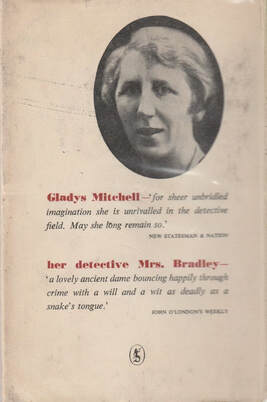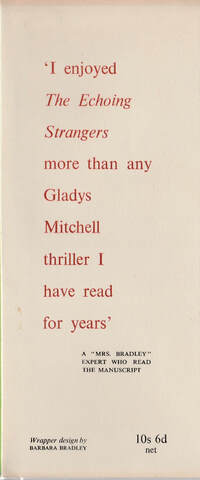While I thank regular readers José and Chris for trying to stay away from SPOILERS as they discuss this section, it is almost impossible to keep the final revelations of these pages alluded to but unnamed. Because Gladys Mitchell herself focuses much of the dialogue and action on culprit and solution, I have decided to quote the readers as they react to the story’s accusations and events. If you have not yet read The Echoing Strangers, you might want to remedy that before proceeding.
SPOILERS AHEAD
We start with
A DRIVING MOTIVATION
It seems clear enough that the boy told his grandfather something that caused his grandfather to threaten him. However, there is no proof whatsoever, and that has been the difficulty throughout this case.
Theda: Now that Francis is talking, Sir Adrian is again threatened by Francis’ knowledge that he caused the car accident. Campbell is killed to frame Francis and damage his credibility. But it’s poorly done, as the fact that Sir Adrian had bought the metal hoops to fix the body to the dinghy was easily determined. I’m still not sure if Campbell was killed because he was a blackmailer, or because he was always out in remote places where it would be easy to kill him without being seen.
Elle: The conversation at the end of the book was very enjoyable and enlightening. I had wondered why something so seemingly idiotic was done to Campbell's body, mainly strapping him to the underside of the boat – anyone who used the boat would surely notice the balance; murder would certainly win out.
Chris: I don’t feel that we have been provided with a satisfactory explanation here for the bizarre stapling of Campbell’s body to the keel of a dinghy. The ‘solution’ is supposedly that the person who arranged this has hoped to implicate a certain suspect, although at the extraordinary risk of himself being identified by the blacksmith – a risk that he takes no steps to reduce: it is the blacksmith here, and not Malachi the diver, who belongs in the thriller role of the Man Who Knows Too Much, and yet nobody attempts to silence him.
A STICKY WICKET
José: Sir Adrian accepts Tom Donagh's challenge, although he suspects Mrs. Bradley to be behind it and he expressly declares her persona non grata at the match. However, Mrs. Bradley manages to get in and confirms some of her suspicions. If it wasn't Derek who killed Witt, who did it? When the match is over, Sir Adrian's team is completely demoralized by their captain’s bad conduct and worse temper.
Joyka: I had decided on Sir Adrian as the killer but no explanation is given as to his tracing Campbell to his lair, killing him with a chunk of concrete Sir Adrian brought from home, and then hauling his body back to the river cottage of Miss Higgs to nail under the boat. That he meant to implicate Francis is the reason given but it seems an overly ambitious plan for Sir A. Sir Adrian is certainly painted as a twisted old man and no loss to society.
Chris: [Also] implausible is the story eventually revealed of the murder weapon employed to kill Campbell. We are supposed to believe that the murderer has transported this object two hundred miles across England (along with a few spares for an equally sinister purpose), even though similar such weapons could readily be found at Wetwode. If the point of this is to plant a clue that indicates the guilt of another character, then it presupposes the arrival of a sleuth so ingenious and lucky that she will be able to find the weapon and then reconstruct its exact history.
ECHOING STRANGELY
José: At the last chapter, before the denouement, Mrs Bradley sums up what it is known so far. To begin with, there are two twins and two murders, each murder being connected, as far as locality is concerned, with one or the other of the twins. The murders have two points of resemblance, but other factors are all different. The murders were each committed in the same way. However, the weapons used were not the same. Both the murdered men were blackmailers. In addition to this, it turns out that at one time they were acquainted with one another. Therefore, there is reason to see a connection between the murders.
Elle: Why would Derek faint when he first encounters Francis with everyone around??
Chris: The climactic event unveiled on the final page is an echo of George Eliot’s classic novel The Mill on the Floss, in which a pair of estranged siblings – although not twins – is reunited in an especially watery finale.
Joyka: I read this book many years ago but all I could really remember was the death of the twins. Two beautiful boys, flawed from the beginning or created by a twisted old man? And there is Miss Higgs, content to live out her life in a cottage where so much hate festered.
FINISHING THE GAME
Elle: The ending: how neatly tied up, with three suicides.
Chris: Gladys Mitchell is not a cheat like Sir Adrian Caux, but she doesn’t exactly play fair with her readers when it comes to setting up and solving the criminal puzzle. The solution turns out to hang on the evidence of a minor and nameless character of whose existence we have been unaware all this time, and then – as if it needed corroboration from a member of the propertied classes – a titled lady, also previously unknown to us, is wheeled on for this purpose. The plot machinery gets especially creaky at this point.
Theda: The ending disappointed me, although I’m not sure how all of this could have been wrapped up otherwise without arrests, court cases, and a lot more exposition. It was fitting, however, that the twins died together.
Joyka: As is often the case with Gladys Mitchell’s mysteries, I found the ending rather abrupt and unsatisfying. I dearly love the Mrs Bradley books except, usually, for the endings. I picture her publisher standing at the door, checking his watch, while GM dashes off the final chapter. And, also, as usual, justice is served but the legal system is thwarted once again.
Theda: This was truly a psychological tale, befitting Mrs Bradley’s area of expertise. This is the first Mitchell book I’ve read; I’m now curious if her other tales are as dependent on the psychology of the characters.
Tracy K: It is pretty clear that there would probably have been no resolution at all to the murders if Mrs Bradley had not stepped in, and that justifies the police asking her to look into the murder in Hampshire. Amateur sleuths often irritate me because they keep running into corpses, and put themselves into unnecessary danger, but in the case of Mrs Bradley, it makes a bit more sense because of her background as a psychologist and her long-term relationship with various law enforcement agencies. Even so, with stories featuring Mrs Bradley, I do have to suspend disbelief quite often. Fortunately, I have never had a problem with that.
Chris: This also [illustrates] what some of us are already accustomed to with Gladys Mitchell: that she is less interested in perfect puzzle-plotting than in such novelistic features as characterization, scene-setting, dialogue, and – we could now add – thematic ‘echoing’.
José: All in all, a reading that I have enjoyed much and one that is well worth reading, in my view.
A heartfelt thank you to all those who participated in this latest Mitchell Mystery Reading Group discussion! I would like to invite all readers to another book reading and conversation from the Mrs Bradley series soon, but my life needs to return to normal first. I will let people know on this blog and over at The Stone House when I am ready to launch the next reading event. Until then, may your May days be free of hearses!









 RSS Feed
RSS Feed